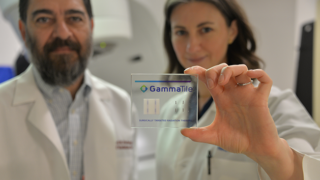Radiation Oncology
Leading the Way in Cancer Care
The Albany Med Health System's accredited radiation oncology is a leader in state-of-the-art technology and treatment methods for adults and children. We work collaboratively with radiation oncologists, nursing specialists, medical physicists, dosimetrists, radiation therapists, and supportive care professionals.
Care Throughout the Capital Region
Radiation oncology services are available at Albany Medical Center, the C.R. Wood Cancer Center at Glens Falls Hospital, and at Saratoga Hospital's Mollie Wilmot Radiation Oncology Center.
All System physicians and locations can be found in the Get Care section of this page.
Accreditation You Can Count On
 The Radiation Oncology programs at Albany Medical Center, Glens Falls Hospital, and Saratoga Hospital are ACRO-accredited. This means our facilities have voluntarily gone through a vigorous review process to be successful in the day-to-day practice of radiation oncology. Our equipment is appropriate for the test or treatment you will receive, and our facilities meet or exceed quality assurance and safety guidelines.
The Radiation Oncology programs at Albany Medical Center, Glens Falls Hospital, and Saratoga Hospital are ACRO-accredited. This means our facilities have voluntarily gone through a vigorous review process to be successful in the day-to-day practice of radiation oncology. Our equipment is appropriate for the test or treatment you will receive, and our facilities meet or exceed quality assurance and safety guidelines.
- Anal Cancer
- Bladder Cancer
- Benign Tumors
- Brain Tumors
- Brain Cancer
- Breast Cancer
- Cervical Cancer
- Colon and Rectal Cancer
- Esophageal Cancer
- Head and Neck Cancer
- Kidney Cancer
- Liver Cancer
- Lung Cancer
- Lymphoma
- Mediastinal Tumors
- Melanoma
- Multiple Myeloma
- Neuroendocrine Tumors
- Ovarian Cancer
- Pancreatic Cancer
- Pediatric Cancer
- Penile Cancer
- Prostate Cancer
- Sarcoma and Other Soft Tissue Tumors
- Skin Cancer
- Spinal tumors
- Stomach Cancer
- Testicular Cancer
- Thymus Cancer
- Thyroid Cancer
- Urethral Cancer
- Uterine and Endometrial Cancer
- Vaginal Cancer
- Vulvar Cancer
- Linear Accelerator: Linac based radiation therapy utilizing (VMAT) Volumetric Arc Therapy, (IMRT) Intensity Modulated Radiation Therapy, and Conformal Beam treatments.
- Advanced Technology: Image Guidance Radiation Therapy (IGRT), 4D Organ Motion Management, and Surface Guidance (SGRT), to precisely locate area of treatment and position the patient.
- External Beam Radiation: This therapy directs high-energy rays from outside the body to the targeted area or tumor.
- Stereotactic Radiosurgey (SRS): Extremely precise technique that allows for the delivery of a highly concentrated dose of radiation in 1-5 treatments to the head.
- Stereotactic Body Radiation Therapy (SBRT): Utilization of special equipment to position a patient in order to deliver a very high dose of radiation to tumors in 1-5 treatments. SBRT technique is often used for lung and liver tumors, and in patients who cannot have surgery.
- Systemic Radiation: Systemic radiation uses radioactive drugs that can be delivered orally or intravenously to treat certain types of cancer.
- Pediatric Radiation Oncology: Radiation oncology services for children, with full pediatric anesthesia are available.
- Radioembolization (Y90): Y90 refers to the radioactive isotope yttrium90, which is inserted into tiny particles and used to deliver radiation directly to tumors via long, thin tubes called catheters.
- Gamma Tile: Surgically Targeted Radiation Therapy (STaRT) is a radiation treatment specifically designed for use inside the brain.
- Image Guided Radiation Therapy (IGRT): Successful radiation therapy is dependent on the ability to deliver substantially more dose to a tumor than surrounding healthy tissue. Image-Guided Radiation Therapy improves dose delivery and allows for superior localization of a tumor relative to healthy tissues.
- Intensity-Modulated Radiation Therapy (IMRT), Volume-Modulated Radiation Therapy (VMAT), Stereotactic Radiosurgery (SRS): Radiotherapy requires delivering the greatest dose possible to a tumor while sparing normal tissues. IMRT, VMAT and SRS are radically new methods of x-ray therapy that are successful at increasing tumor dose while reducing side effects.
- Brachytherapy: Brachytherapy is a form of radiotherapy in which small radioactive sources are placed directly into or near a tumor. Our radiation oncology department has an active brachytherapy service. High-dose-rate brachytherapy, offered at Saratoga Hospital and Glens Falls Hospital, has given breast cancer patients an alternative to external beam therapy and has greatly improved the implant treatment of endometrial cancer and cervical cancer.
- CT Simulator: High-speed multi-slice CT simulator can return high-resolution imaging with great speed and accuracy.
CT Simulation: One CT Simulation vault that encompasses a Philips Big Bore CT. This CT scanner enables the team to perform the patient’s CT Simulation, fabricate necessary immobilization devices, as well as utilize the wide 85cm bore to properly position the patient for treatment.
Treatment Machines: Two treatment vaults that house the Varian 21ix™ and TrueBeam™ systems. These fully integrated radiation therapy systems deliver unmatched precise, high-dose radiation therapy. They are used to deliver all forms of external-beam radiation therapy, including 3-Dimensional Conformal Radiation Therapy (3D-Comformal), Intensity Modulated Radiation Therapy (IMRT), Stereotactic Cranial Radiosurgery (SRS), Stereotactic Body Radiation Therapy (SBRT), as well as the ability to perform Image-Guided Radiation Therapy (IGRT), utilizing the advanced imaging hardware combined with state-of-the-art software.



